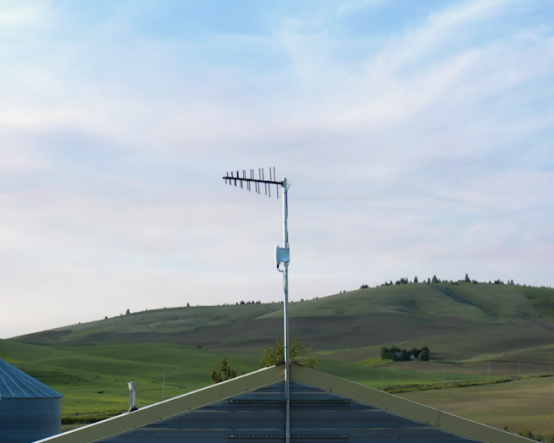Over 820,000,000 people worldwide are hungry.
The world has a problem with how to feed its people. As the earth’s population continues to grow, farmers are struggling to meet those needs.
Without discovering new ways to produce more of the nutritious food people need to thrive, the number of hungry people worldwide—currently over 8 hundred million 1 —could grow exponentially. Find out why AI-powered technology may be the solution farmers have been searching for to boost their potential.
As the world’s population continues to grow—it’s projected to reach 9.3 billion by 2050 2 —the amount of farmable land is decreasing: we’re currently using two times the resources the earth can replenish. Climate change is only making it more difficult for farmers to produce enough food to feed the millions of people who are hungry today.
Yet there is hope to address this modern food crisis: We can grow more while using fewer resources with the help of AI powered technology. Data generated using tools such as drones, satellites, and sensors provides farmers with greater insight into their land. Project FarmVibes, created by Microsoft Research, utilizes AI to analyze data collected on farms, helping farmers to make more informed decisions and enabling them to scale food production in order to help meet the 70% increase needed by 2050. 3
“We believe that data, coupled with the farmer’s knowledge about their farm, can help increase farm productivity and also reduce the resources needed to do so,” says Ranveer Chandra, CTO of Agri-Food at Microsoft. “The goal is for every farmer to be empowered to use AI to increase crop production to meet the needs of the growing population.”
Agriculture meets
software
Andrew Nelson knows first-hand the impact of climate change on his family’s livelihood. “Last year we had the second driest year on record. The year before we had one of the wettest years on record,” he says. “We’re continually facing different challenges on our farm created by climate change.”
As a fifth-generation wheat farmer in Washington State and a software engineer, he’s in a unique position to combine traditional techniques with new AI technologies to increase sustainability and food production.
“I like to combine my passions of software and agriculture to try to make what we do better in every way. When I blend technology with my family’s generational knowledge, I have the best information available to help our farm thrive in the future.”

The technology of a farm
Families who have farmed for generations, like Andrew’s, rely on the valuable traditions they have learned over the generations, such as feeling the soil.
Now, AI can help them merge data from precision agriculture tools like sensors, drones and satellite imagery. Agricultural expertise, combined with AI, can lead to greater insights, and ultimately, more sustainable farming.
Click or use your arrow keys to explore technology on a farm.
How can massive amounts of data from a farming “dead zone” move to the cloud?
Capture intelligent data from FarmVibes.Edge drone-scouting flights
“We process a lot of our data on Edge devices in my office—one drone flight that takes 30-40 minutes can generate 15-20 gigabytes of data,” says Nelson. “With a normal farm’s internet connection it would take hours or days to upload to the cloud—but we stitch it locally and use AI to intelligently upload it to the cloud so we’re able to see the data immediately and act on it right away.”
How on Earth do you get WiFi connectivity on a remote wheat field?
Hack unused TV frequencies as WiFi with wireless sensors
“Enabling Wi-Fi through the sensors allows us to find out about an impending frost or freeze in a more hyperlocal way versus what the weather forecast says. It has been so valuable because it has prevented me from injuring my crop by applying chemicals that are needed to take care of something else, but it could wait a few days if it’s supposed to freeze. Internet white spaces enable me to have that data at my fingertips, no matter where I am on my farm,” says Nelson.
How can farmers be empowered to make more accurate predictions with a single computer?
Merge data from multiple sources using FarmVibes.AI to create an intelligent map of the farm
“The drone stitching has made a big difference: my great grandfather had smaller fields, they weren’t trying to manage such a big farm,” says Nelson. “But for me, with the drone flight information, I can quickly see every part of a 300 acre field in minute detail. Then I can use that data to make decisions on precisely where to spray for weeds. This technology allows me to conserve resources and only use what I need.”
Slide the drone or use your arrow keys to see how field images are stitched together.
It would take a farmer hours or days to walk through their entire farm, but with a drone, they can capture images of their entire farm in minutes.
A hopeful future
Despite the challenges of a growing population and shrinking food supply, AI-powered technology is giving farmers around the world reasons to be optimistic, from family-run American farms like Andrew’s to smallholder farmers in impoverished areas of India. Just a few tools—sensors, satellites, drones and AI powered processing—can build on the expertise that farmers have, providing data and insights that have the capacity to meaningfully increase crop production, while using fewer resources.
“Over the next year, we’re working hard to connect more smallholder farmers to sustainable agriculture practices,” says Chandra. “By leveraging AI technology, we can empower farmers around the world to gain the kind of insights that can help feed our planet’s growing population.”
“By increasing access and sharing innovation, we can address the impending food crisis,” says Nelson. He’s doing his part – and he hopes that it will allow his future farm—and others around the world—to thrive.
As long as I am innovating to keep my farm sustainable, if my children want to come back to farm—which I hope they do—then they will have something to carry forward.
References
- Food and Agriculture Organization of the United Nations. (2022.) Food security and nutrition indicators. State of Food Security and Nutrition in the World 2022. Retrieved from: https://www.fao.org/3/cc0639en/online/sofi-2022/food-security-nutrition-indicators.html
- United Nations Department of Economic and Social Affairs. (2019, June 17.) The 2017 Revision of World Population Prospects. United Nations News. Retrieved from: https://www.un.org/en/desa/world-population-projected-reach-98-billion-2050-and-112-billion-2100
- U.S. Department of Agriculture. (n.d.). Food security. USDA Topics. Retrieved from: https://www.usda.gov/topics/food-and-nutrition/food-security


















